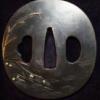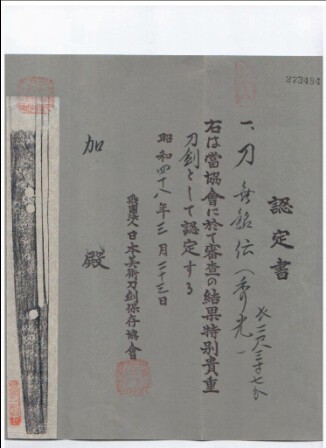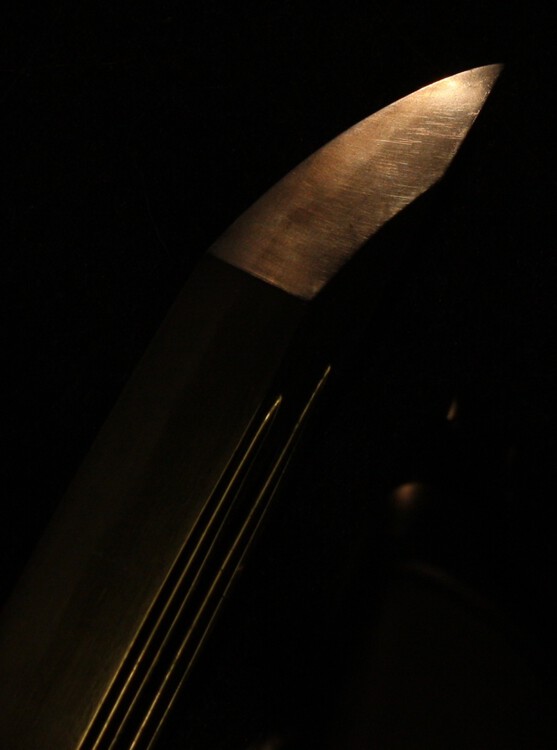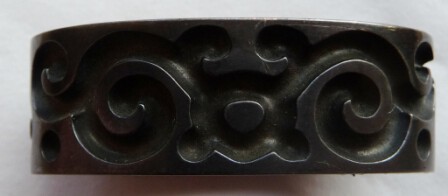-
Posts
497 -
Joined
-
Last visited
-
Days Won
1
Content Type
Profiles
Forums
Events
Store
Downloads
Gallery
Everything posted by Veli
-
Morita-san, Is this a capture from a book that lists the different cursive styles of common kanji encountered in mei? If so, could you please tell us which book it is. I would like to buy one if possible... Best Regards, Veli
-
Jim, I am strongly in favor of academic discussion based on excellent photographs! However, it would be a good idea to provide a link to the seller's pages, in order to give access to all the available information and additional pictures. Did you ask Tsuruta-san's permission for copying the pictures on AOI-ART webpages? BR, Veli
-
Please note that this blade is currently for sale (auction) on AOI-ART webpages. Clearly indicated by Tsuruta-san as gimei. BR, Veli
-
Well, if we trust what the papers say (den Hidemitsu), this is a Bizen Kozori blade from around late Nambokucho period with workmanship resembling that of Hidemitsu. BR, Veli
-
...and here are the Tokubetsu Kicho papers (with an interesting year of issue, by the way). BR, Veli
-
Hello Thomas! You forgot to attach a picture... BR, Veli
-
-
Hi all! This is the blade that was inside the koshirae with the guribori fuchikashira discussed last week in the tosogu section. It is a somewhat tired blade, but it has a lot of nice details to study. I'll let people make a guess of the tradition and school before I let you know what the old green papers say (not to be 100% trusted)... Nagasa is 69 cm, by the way. BR, Veli
-
I guess Chris is right... http://www.ksky.ne.jp/~sumie99/suriage.html (scroll to the bottom of the page) It is difficult to imagine a smith deliberately producing such a strange shape. BR, Veli
-
First of all, thanks to you all for this enlightening discussion! Once more I have learned a lot by simply asking a question in this excellent forum I hope Ford shares his deeper, practical and theoretical knowledge with us, but while waiting for that I'll try to explain some basics of the process (what I think it is), since I have actually done that during my engineering career. There is a metallurgical process called diffusion welding. If we press a stack of conformal, preferably planar, metal sheets together with a very high force, and simultaneously heat the stack close to, but not quite at the melting temperature, the metal atoms start to diffuse across the interface of the sheets without actual melting of the metals. This produces a very high-quality joint between the said metals, provided they are unoxidized, untarnished, under uniform pressure, and the surfaces are very smooth. What I do admire deeply, is the fact that the 17th century artists did this without modern tools and equipment, like accurately machined pressing tools, vacuum ovens (in vacuum one does not need to worry about surface oxidation), temperature sensors... BR, Veli
-
Stephen, are you referring to this one: http://www.militaria.co.za/nmb/viewtopic.php?f=2&t=2164? Brian, I'll be happy to post some pictures of the blade. I still need to have a photography session with the new blade (during next weekend I hope...) I am a man with limited financial resources, so please do not expect too much. The blade is slightly tired, but wears its great age graciously. It has strong characteristics, so I hope it will arouse some interesting and educational discussion. But that will be in another topic! Ford, thank You very much for the information. That was surprising: I have done myself some diffusion bonding of silver with modern vacuum tools, and that was a headache. I thought the process of layer-welding would have been very difficult and consequently very costly, but maybe labor was cheap in respect to raw materials back then? And yes, the mei is a piece of art in its own right... BR, Veli
-
John, Thank You for the clarification of the term. "High relief carving" sounds the right word. Can you say whether this wide, deep carving pattern with curve-based geometry emerged via the invention of the guribori/mokumegane method, or was it used in sword furniture already earlier in the history? BR, Veli
-
Dear friends, I recently acquired a katana (o-suriage tachi) in koshirae. The fuchikashira carving resembled the guribori style, but the metal was homogeneous shakudo, i.e. not layered. The fuchi was signed "Takahashi Masatsugu (Kao). I wonder what I should call this carving style, and whether it is a copy or just an "affordable" version of the famous guribori method by the same artist. The workmanship looks decent and the signature skillfully carved, but I lack both expertise and tosogu references to evaluate whether it is original... In any case the fuchikashira had very little to do with my decision to acquire the sword in question, apart from that it did not seem clumsy. BR, Veli
-

NTHK-NPO 2011 UK Shinsa
Veli replied to pcfarrar's topic in Sword Shows, Events, Community News and Legislation Issues
The new year 2011 makes me feel optimistic, and thus I dare to enquire: Are there any chances of resurrecting the idea of a UK (or European) NTHK/NPO shinsa? Happy new year to all nihontophiles, on any continent! BR, Veli -
Looks nice, no coal in your stockings this Christmas :D Asking just for personal interest: are there ko-ashi in the hamon? Cannot resolve such detail in the pictures... BR, veli
-
Tokushu tetsu Ido Hidetoshi saku? Can anybody enlighten us about Tokushu steel? 特殊=special? This is a gunto, i.e. an arsenal production blade from around WWII. The more knowledgeable guys may tell you whether the steel is somehow special. Looks nice for a gunto. It is a hand made but not a traditionally made (tamahagane) blade, however. BR, Veli
-
Hidetoshi seems to have a Seki arsenal stamp. BR, Veli
-

Need assistance, please with translation on nakago
Veli replied to smorrill's topic in Translation Assistance
Probably the smith listed in Hawley's as KAN468, KAN50. Early 18th century, Kaga province, Kanazawa town, Hawley 15 points. Also signed Kanehiro. BR, Veli -

Need assistance, please with translation on nakago
Veli replied to smorrill's topic in Translation Assistance
Just a quick guess: Kashu Kanazawa ju Fujiwara Kaneyoshi 加州金澤住藤原包義 BR, Veli -
I wonder whether this guy used gloves when laying the blade down... http://www.huuto.net/kohteet/antiikki-katana-miekka-wakizashi-japani-edo-aika/153962477 Veli
-
I have understood handling the nakago with bare hands is essential for the development and preservation of a correct kind of patina. Veli
-
Roy, Stephen, Could you elaborate a bit with the timing... If we assume this blade would be older than shinshinto, wouldn't it then logically originate from late 16th or early 17th century? Wouldn't placing this blade into mid 17th century make it rather exceptional, since few tantos were made in those days, or at least so they say in the books ? BR, Veli
-
Stephen, It may well be an older blade than what I first thought. However, tanto were rare from mid to late 17th century. Also what is peculiar, the blade seems to be polished several times, but there seems to be no hadaware visible in the photos (Thomas, can you see any ware when holding the blade in hand?). If the tanto would be a late koto one, I'd expect core steel and consequently some ware to show. The steel looks "tighter" than one would expect, which might indicate a late date of manufacture? Maybe early shinto? Somehow I still think it is more recent, but I may well be wrong. BR, Veli
-
Well, as I said its all guesswork. The nakago patina looks indeed older than 19th c., but the burr in the mei still has sharp features. Furthermore, there is only one mekugiana. The depth of the chiselling varies a lot, especially in the "作" -kanji. BR, Veli
-
Hello Thomas! Impressive mounts! Somehow I get the feeling that the blade is from the 19th century (Hada is not really visible, habuchi is dim, and the mei looks rather young, and not too elegantly carved). I may be mistaken as well, but I'd say the blade is definitely not from the 14th century, probably not from the 16th, either. There was a number of Kunihiros also in the 19th century. This is a personal and unlearned opinion only. Please wait for more knowledgeable answers! BR, Veli












